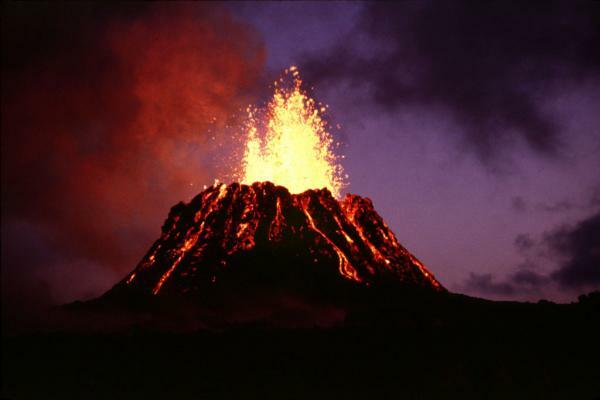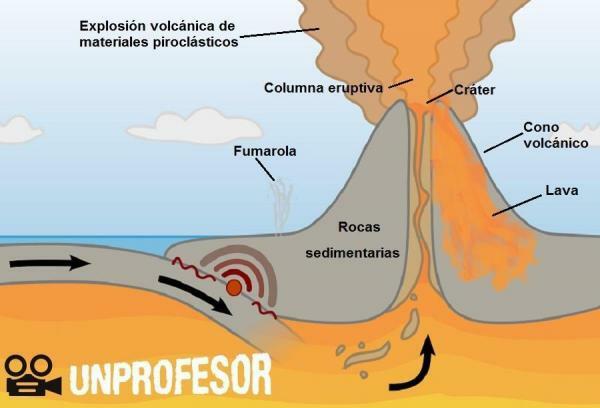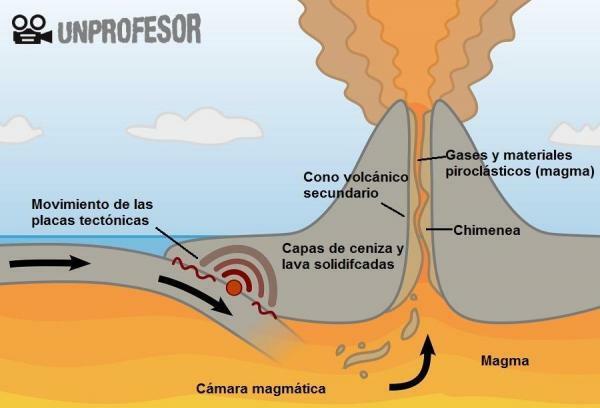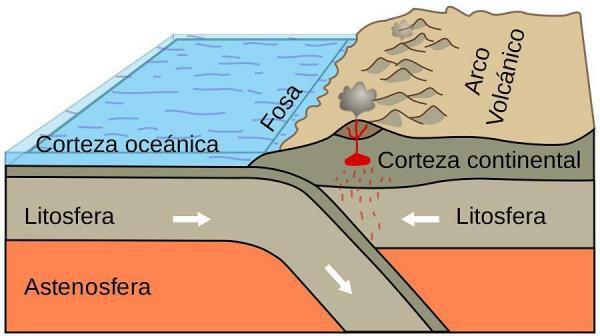The parts of a volcano

Volcanoes are geological structures in the form of mountains through which magma, molten rock from the interior of planet Earth, is expelled in the form of an eruption at a very high temperature. When one of these geological formations erupts, or erupts every so often, it is considered a volcano. active, on the other hand, one that has never had an eruption, or after many years without activity, is called a volcano inactive. On our planet there are many geological structures of this type and, due to the movement of the tectonic plates, most are found in the coasts of the Pacific Ocean, from America to Asia and Oceania, covering 21 countries that are in the area known as the ring of fire.
In this lesson from a teacher we are going to explain the parts of a volcano and its definition in a practical way so that it is easier for you to study both the external and internal parts. In addition, we will also discuss how volcanoes are formed.
To know the parts of a volcano we must start with the external ones, which are those that are found on the surface of the earth's crust, that is, on the outside. Some of these parts are only visible when there is activity, therefore, to have the maximum information about how these geological masses are composed, we will explain
the outer parts of an erupting volcano:- Volcanic cone: It is a mountain that has a conical or cone shape that has been formed over time with materials such as sedimentary rocks, pyroclasts, lava and solidified ash. It is wide at the base and narrows as it approaches the top where it has the crater. We can say that this cone is the basic structure and shape of this geological structure.
- Crater: is the opening in the upper part of the cone, the hole through which gases, smoke, ash, lava and other materials that a volcano expels, that is, it is the mouth of the volcano through which the magma leaves Exterior. Typically, a crater is several kilometers in diameter and can be circular or oval in shape.
- The eruptive column: It is the column of smoke, gases and lava that comes out directly from the crater vertically and with a lot of energy due to the explosion.
- The volcanic explosion of pyroclastic materials: It is the cloud of the explosion composed of lava, gases and other minerals. Due to the energy of this explosion, they are thrown out of the crater, becoming part of the new layers of the main cone when they cool down.
- Wash: It is made up of various molten minerals at a very high temperature, it is magma when it comes out. Until it cools it destroys the environment of the volcano due to the high temperature and, when it finally cools, it becomes part of the cone.
- Fumaroles: gas emissions derived from lava when it is still at elevated temperatures.
- Sedimentary rocks: They are the material of the earth's crust that makes up the volcano on the outside, together with which they uniting the different pyroclasts that come out in the explosions and that increase the surface of this formation geological.
- Solfataras: they are part of the emissions from the explosion and are made up of hydrogen sulfide and water vapor.
- Skunks or cold fumaroles: They are fumaroles that expel carbon dioxide and that have a temperature well below the rest of the parts of this geological structure.
- Geysers: Small volcanoes that are found at different points at the base of the main cone and that only expel water vapor at very high temperatures.

To finish explaining the parts of a volcano, we can only comment on the internal parts of this geological structure, which are those that are found below the earth's surface. As it is important to know all the components of these geological formations that connect the interior of the planet with the surface, we are going to explain in detail what they are the internal parts of an erupting volcano:
- Tectonic plate movement: Although it is not in itself a part of a volcano, we must mention one of the causes for which an eruption can occur. The tectonic plates that make up our planet are in constant motion, when there is very strong movements are known as seismic movements that sometimes we can notice and that we call earthquakes. These movements of the plates when they occur in volcanic areas usually cause the magma to escape to the interior. Also, many times this movement has been caused because the magma, due to the reactions of the gases it contains, seeks to rise to the surface.
- Magmatic chamber: It is the inner part of the Earth that contains magma and that is in connection with the surface through volcanoes.
- Magma: internal material of the Earth that is composed of molten minerals at high temperatures. When certain reactions occur in the gases produced by magma when it is constantly at a very high temperature, it rises to the surface.
- Volcanic chimney: It is the connection between the magma chamber and the exterior, so it is the internal column through which the magma circulates when it needs to come to the surface.
- Eruptive fissures: Sometimes the magma does not rise to the surface through the chimney, but rather through some lateral fissures in the cone, the lava spilling down the sides.
- Pyroclastic gases and materials: pyroclasts, gas, smoke and all the materials that make up magma as it circulates through the chimney, before being expelled and becoming what is known as lava.
- Solidified ash and lava layers: They are the different layers that make up the interior of the cone, which is why they are also known as the secondary volcanic cone. It is all the materials that a volcano expels on previous occasions and that, when cooling, have formed the cone.
- Lava flows: magma bodies that have little lateral continuity and therefore travel a short distance. When this lava comes to the surface, it solidifies forming obsidians, basalts and rhyolites.

Volcanoes are geological formations, usually conical, on the surface of the earth's crust and that connect with the deeper layers of the crust to the interior of the Earth, where the magma. In addition, there are various types of volcanoes, such as shield volcanoes or stratovolcanoes among others.
Usually, volcanoes can be formed in three ways different depending on the point of the crust where they are created:
- The volcanoes of the divergent frontiers: it is about those that are formed in the parts in which two plates separate. They are more common in the oceanic crust. It is a point where magma has an easy way to start creating a volcano.
- The volcanoes of the convergence frontiers: point at which two plates meet as they move. When this happens one of the plates moves under the other, a process known as subduction. This means that the magma can easily rise through this area although, normally, what happens is that the subducting plate descends so much towards the mantle that it ends up dehydrating and melting, thus forming the magma that will come out through the fissures at that point and will form a volcano.
- Volcanoes in hot spots: They are the points of the crust where the magma rises from different veins that come from the mantle and, due to the pressure it exerts, moves the plates, forming a volcano.
The volcano formation process is complex, and typically follow these steps:
- Magma forms inside the Earth at very high temperatures
- Rise to the top of the crust
- Its emission occurs through cracks in the cortex
- The materials that make up the magma accumulate on the surface of the crust that, with the passage of time and various eruptions, create the volcanic cone


